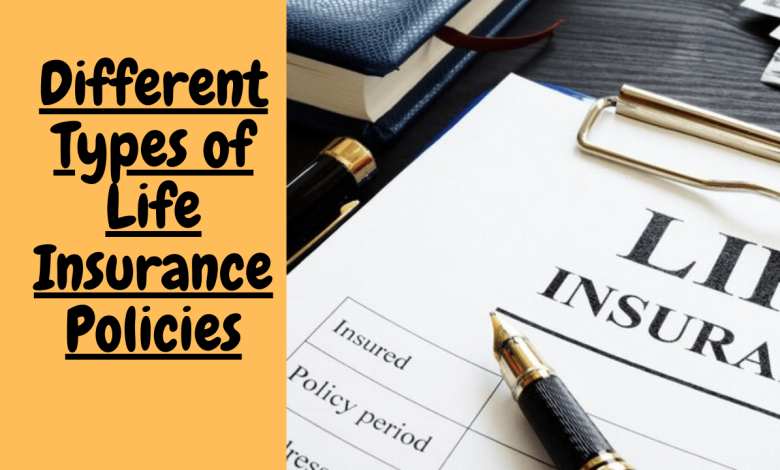
Different Types of Life Insurance Policies
Types of Life Insurance Policies Life insurance is an essential financial tool that provides financial security and protection for your loved ones in the event of your death. It ensures that your beneficiaries receive a lump sum payment, known as the death benefit, which can be used to cover various expenses such as mortgage payments, education costs, or daily living expenses. However, not all life insurance policies are the same. There are several types of life insurance available, each with its own features, benefits, and drawbacks. In this article, we will explore the different types of life insurance policies to help you make an informed decision.
Comparing Different Types of Life Insurance:
To provide a comprehensive overview of the different types of life insurance, here is a comparison table:
| Insurance Type | Policy Length | Cash Value | Premiums | Death Benefit | Who is it for | Downside |
| Term Life Insurance | Fixed term | No | Lower | Yes | Temporary needs | No coverage after term ends |
| Whole Life Insurance | Lifetime | Yes | Higher | Yes | Lifelong needs | Higher premiums |
| Universal Life Insurance | Lifetime | Yes | Flexible | Yes | Flexibility | Requires active management |
| Variable Life Insurance | Lifetime | Yes | Flexible | Yes | Risk tolerance | Investment risk |
| Burial Insurance | Lifetime | Yes/No | Lower | Yes | Funeral expenses | Limited coverage amount |
| Survivorship Life Insurance | Lifetime | Yes | Lower | Yes | Estate planning | No immediate coverage |
Term Life Insurance

Term life insurance is one of the most popular and straightforward types of life insurance. It provides coverage for a specific period, typically 10, 20, or 30 years. Here are the key features of term life insurance:
Policy length: The policy lasts for a fixed term, and coverage ends if the policyholder outlives the term.
Cash value: Term life insurance policies do not accumulate cash value over time.
Premiums: Premiums for term life insurance are generally lower compared to other types of policies.
Death benefit: In the event of the policyholder’s death during the term, the beneficiaries receive the death benefit.
How it works: The policyholder pays regular premiums, and if they pass away during the term, the beneficiaries receive the death benefit.
Who is it for: Term life insurance is suitable for individuals who want temporary coverage to protect their dependents during specific financial obligations, such as mortgage payments or children’s education expenses.
Downside: Once the term ends, the coverage terminates, and if the policyholder wants to renew, it may come at a higher premium due to age or health changes.
Whole Life Insurance

Whole life insurance is a permanent life insurance policy that provides lifelong coverage and builds cash value over time. Types of Life Insurance Policies Here are the key features of whole life insurance:
Policy length: Whole life insurance provides coverage for the policyholder’s entire lifetime.
Cash value: Whole life policies have a cash value component that grows over time and can be accessed through policy loans or withdrawals.
Premiums: Premiums for whole life insurance are higher compared to term life insurance, but they remain level throughout the policy’s duration.
Death benefit: The beneficiaries receive the death benefit upon the policyholder’s death.
How it works: Policyholders pay premiums throughout their lives, and a portion of the premium goes towards the cash value component.
Who is it for: Whole life insurance is suitable for individuals who want lifelong coverage and are interested in accumulating cash value that can be used for future needs or as an investment.
Downside: Whole life insurance is more expensive than term life insurance, and the cash value growth is generally slower compared to other investment options.
Universal Life Insurance
Universal life insurance is another type of permanent life insurance that offers flexibility in premium payments and death benefit amounts. Types of Life Insurance Policies Here are the key features of universal life insurance:
Policy length: Universal life insurance provides coverage for the policyholder’s entire lifetime.
Cash value: Universal life policies accumulate cash value, which can be used to pay premiums or increase the death benefit.
Premiums: Policyholders can adjust the premium amount and frequency within certain limits, providing flexibility.
Death benefit: The beneficiaries receive the death benefit upon the policyholder’s death.
How it works: Policyholders can allocate their premium payments towards the cash value component or the cost of insurance. They can also adjust the death benefit amount over time.
Who is it for: Universal life insurance is suitable for individuals who want flexibility in premium payments and death benefit amounts, as well as the opportunity to build cash value.
Downside: Universal life insurance policies are complex and require active management. If the policy’s cash value is insufficient to cover the costs, premiums may need to be increased to maintain coverage.
Variable Life Insurance
Variable life insurance combines life insurance protection with investment options. Policyholders have the opportunity to invest in various investment accounts such as stocks, bonds, or mutual funds. Types of Life Insurance Policies Here are the key features of variable life insurance:
Policy length: Variable life insurance provides coverage for the policyholder’s entire lifetime.
Cash value: The cash value in variable life insurance fluctuates based on the performance of the investment accounts chosen by the policyholder.
Premiums: Premiums for variable life insurance are flexible, allowing policyholders to adjust their premium payments.
Death benefit: The beneficiaries receive the death benefit upon the policyholder’s death.
How it works: Policyholders allocate their premium payments into different investment accounts and bear the investment risk. The cash value and death benefit depend on the performance of the chosen investments.
Who is it for: Variable life insurance is suitable for individuals who have a higher risk tolerance and are comfortable managing their investment portfolio within their life insurance policy.
Downside: The investment component of variable life insurance exposes policyholders to market volatility, and poor investment performance can lead to a lower cash value or death benefit.
Read more About What Are The Principal Types of Life Insurance Click Here ?
Burial Insurance/Funeral Insurance:
Burial insurance, also known as funeral insurance or final expense insurance, is designed to cover funeral and burial expenses. Types of Life Insurance Policies Here are the key features of burial insurance:
Policy length: Burial insurance provides coverage for the policyholder’s entire lifetime.
Cash value: Some burial insurance policies may accumulate cash value, while others simply provide a death benefit.
Premiums: Premiums for burial insurance are typically lower compared to other types of life insurance.
Death benefit: The death benefit is paid to the beneficiaries to cover funeral and burial costs.
How it works: Policyholders pay regular premiums, and upon their death, the beneficiaries receive the death benefit to cover funeral expenses.
Who is it for: Burial insurance is suitable for individuals who want to ensure that their funeral and burial expenses are covered and do not burden their loved ones financially.
Downside: The death benefit of burial insurance is usually smaller compared to other types of life insurance, as it is intended to cover specific expenses rather than provide long-term financial protection.
Survivorship Life Insurance/Joint Life Insurance:
Survivorship life insurance, also known as joint life insurance, covers two individuals under one policy. The death benefit is paid out after the death of both insured individuals. Here are the key features of survivorship life insurance:
Policy length: Survivorship life insurance provides coverage until the death of both insured individuals.
Cash value: Survivorship life insurance policies may accumulate cash value over time.
Premiums: Premiums for survivorship life insurance are typically lower compared to two separate individual policies.
Death benefit: The death benefit is paid out after the death of both insured individuals.
How it works: Policyholders pay regular premiums, and the death benefit is paid out after the death of both insured individuals.
Who is it for: Survivorship life insurance is often used for estate planning purposes, such as providing funds for estate taxes or leaving a legacy for beneficiaries.
Downside: Survivorship life insurance does not provide immediate financial protection upon the death of one insured individual. It may not be suitable for those who require coverage for income replacement or immediate financial needs.
Mortgage Life Insurance:
Mortgage life insurance, also known as mortgage protection insurance, is designed to cover the outstanding balance of a mortgage in the event of the policyholder’s death. Here are the key features of mortgage life insurance:
Policy length: Mortgage life insurance provides coverage for the duration of the mortgage.
Cash value: Mortgage life insurance policies do not accumulate cash value.
Premiums: Premiums for mortgage life insurance are typically level and based on the mortgage amount.
Death benefit: The death benefit is paid out to cover the remaining mortgage balance.
How it works: Policyholders pay regular premiums, and if they pass away during the mortgage term, the death benefit is used to pay off the outstanding mortgage balance.
Who is it for: Mortgage life insurance is suitable for homeowners who want to ensure that their mortgage will be paid off if they pass away, providing financial security for their family.
Downside: Mortgage life insurance typically pays out only the outstanding mortgage balance and does not provide additional funds for other expenses. As the mortgage balance decreases, the coverage amount also decreases.
Credit Life Insurance
Credit life insurance is specifically designed to cover outstanding debts, such as credit card balances or loans, in the event of the policyholder’s death. Here are the key features of credit life insurance:
Policy length: Credit life insurance provides coverage for the duration of the debt.
Cash value: Credit life insurance policies do not accumulate cash value.
Premiums: Premiums for credit life insurance are typically based on the outstanding debt balance.
Death benefit: The death benefit is paid out to cover the outstanding debt balance.
How it works: Policyholders pay regular premiums, and if they pass away with outstanding debt, the death benefit is used to pay off the debt.
Who is it for: Credit life insurance is often offered by lenders as an option when taking on a new loan or credit card, providing protection for the borrower’s beneficiaries in case of death.
Downside: Credit life insurance coverage is limited to the outstanding debt balance and does not provide additional funds for other expenses. The premiums may also be higher compared to other types of life insurance.
Supplemental Insurance:
Supplemental life insurance is designed to supplement an existing life insurance policy and provide additional coverage. It is typically offered as a rider or add-on to a primary life insurance policy. Here are the key features of supplemental insurance:
Policy length: Supplemental insurance provides coverage for the duration specified in the policy.
Cash value: Supplemental insurance policies may or may not accumulate cash value, depending on the terms.
Premiums: Premiums for supplemental insurance vary based on the additional coverage provided.
Death benefit: The death benefit is paid out in addition to the primary life insurance policy’s death benefit.
How it works: Policyholders pay additional premiums for supplemental coverage, and the death benefit is paid out in addition to the primary policy’s death benefit.
Who is it for: Supplemental insurance is suitable for individuals who want to increase their coverage beyond what their primary life insurance policy provides, such as during specific periods of higher risk or life events.
Downside: The cost of supplemental insurance can increase the overall premiums paid for life insurance coverage.



